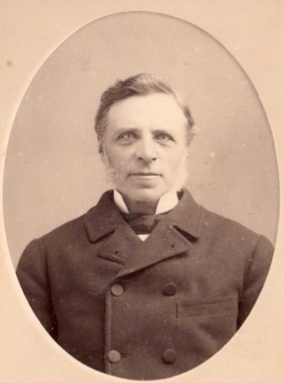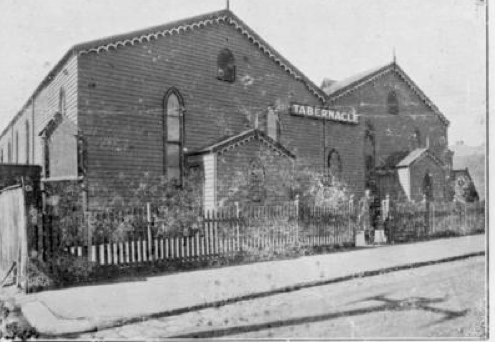Collingwood Notables Database
Charles Mortimer Cherbury
1837-1917
Minister
English-born Charles Cherbury was a Baptist minister, who became the first incumbent of the Sackville Street Baptist Tabernacle, a position he held from 1874 until 1893. With a small number of Baptist adherents he established worship in a small hall in Gold Street, Collingwood, in January 1874. The congregation speedily grew, and within a few years construction of the church began in nearby Sackville Street.
Prior to beginning his work in Collingwood, Cherbury had been a pastor among country congregations in Ararat, Beaufort, Ballarat and Tarnagulla. He married German-born Christine Almstedt in 1861. On coming to Melbourne in the early 1870s he first took up the pastorship of the George Street Baptist Church in Fitzroy, where he rented a nearby house in the same street for his growing family.
In Collingwood Cherbury, along with the ministers of other denominations such as the Methodists, was faced with a populace of many poor and struggling people, but his congregation continued to grow, and the church soon needed enlarging. When finally completed it held 1200 people, and in Cherbury's time it was regularly overcrowded on Sunday nights.
In 1879 Cherbury instigated a charity called Homes of Hope and set up a home for destitute children, who had been deserted by their parents, or left orphans, or whose parents were in jail for lengthy periods. This was not a local institution but was available for children from any area. A stated goal of the committee was to offer a superior option to the Government-run Industrial Schools and Reformatory Schools. The Home opened in 1880 in an old boot factory in Sackville Street, next to the Baptist Tabernacle. Before long land was purchased in Easey Street, immediately behind the Tabernacle, and a new building, which eventually incorporated 23 rooms, was constructed in the mid 1880s. Cherbury remained superintendent until the mid 1890s. At first the children walked to a State School, but as it was ascertained that the children were often waylaid en route by undesirable companions including relations described as ‘dissolute women and intoxicated men’, a school room was added. The teacher was one of Cherbury’s daughters, either Hermina or Henrietta. The Home eventually closed around 1925 and was demolished.
In the meantime, Cherbury had purchased a home of his own, Arthur Villa, in Delbridge Street, North Fitzroy. Then, suffering from mental strain, he took eight months leave of absence; money was raised to fund a trip to the old country in 1882-83. During his absence the Reverend John Alexander Dowie took charge, but this was not a happy time for the congregation. Dowie made some criticisms of Cherbury’s stewardship, such as the fact that he had sole charge of all funds without involving the Treasurer. Very early in his ministry he clashed with the church stewards over abstinence meetings, and chastised them for their disobedience to him as their appointed minister. The remainder of his tenure seems to have involved ongoing disagreements and criticism among the congregation, finally including Mrs Cherbury and her eldest son Charles. Much of this was played out in the press, but Dowie published his own side of the story in a lengthy pamphlet entitled, rather luridly, Sin in the camp. When Cherbury returned, Dowie formed the Fitzroy Free Church, taking with him some members of the Sackville Street congregation, including PercyRendle.
Cherbury returned to Arthur Villa, his wife, and six surviving unmarried children. His eldest daughter Elizabeth had already married, in 1881, Albert Rivett, a Congregational minister and pacifist who also preached at the Baptist Tabernacle from time to time, and may have been a committee member of the Homes of Hope charity. Charles and Christina spent over twenty years at ArthurVilla;between 1885 and 1899 Charles Philip, Hermina, and Henrietta (Hetta) married, and Arthur and Grace died.
In 1888 he initiated a new charitable project called Pilgrims Rest, to accommodate aged destitute gentlewomen. Once donations were sufficient, the home was established in Alphington.
Cherbury seems to have been a successful and popular preacher. In addition to his sermons, he gave lectures on topics of general interest such as ‘The Dutch Nation’ and one on physiognomy for the Clifton Hill Mutual Improvement Society, held in St Andrew’s Anglican church schoolroom in Clifton Hill. Cherbury and Christine moved to Ramsden Street in Clifton Hill in the new century.
The Cherburys were frequent visitors to NSW and both died there. Their eldest son Charles Philip and his wife lived at Hurstville in NSW, while daughter Elizabeth Rivett lived in Sydney. In later life Charles Philip and Margaret managed an Aboriginal mission in NSW. Elizabeth was a dedicated Sunday School teacher and produced a family of six, all of whom went on to illustrious careers. In 1915 Christine died at her daughter’s house. Two years later Charles was again visiting Sydney, where he died.
43 Ramsden St in 2018
Life Summary
| Birth Date | Birth Place |
|---|---|
| 1837 | Plymouth, England |
| Spouse Name | Date of Marriage | Children |
|---|---|---|
| Christina Elizabeth Almstedt, 1840 - 26 February 1915 | 1861 | Elizabeth Mary Ann c. 1862, Charles Philip, Ararat 1863; Hermina, Beaufort 1865; Alexander, Beaufort 1868; Henrietta, Beaufort 1869; Herbert William, Tarnagulla 1871-1879; Arthur Henry, Collingwood, 1876-85; Catherine Sophia, Collingwood 1874-1875; Grace Eveline, Fitzroy 1882. |
| Home Street | Home City | Status of Building |
|---|---|---|
| 230 George Street | Fitzroy | |
| 39 Delbridge Street | Fitzroy North | Extant |
| 43 Ramsden Street | Clifton Hill | Extant |
| Work Street | Work City | Status of Building |
|---|---|---|
| Sackville Street | Collingwood | Demolished |
| Church | Lodge |
|---|---|
| Sackville Street Baptist Tabernacle |
| Death Date | Death Place | Cemetery |
|---|---|---|
| 1917 | Balmain North, NSW |
The Age; The Argus; The Herald; Weekly Times; Mercury and Weekly Courier; Baptists in Victoria: our first century, 1838-1938; Cummings, Bitter roots, sweet fruit.
Find and connect: Home of Hope




